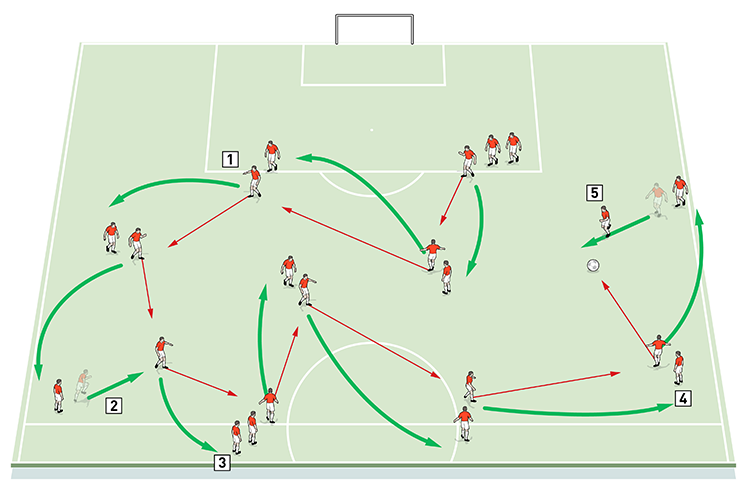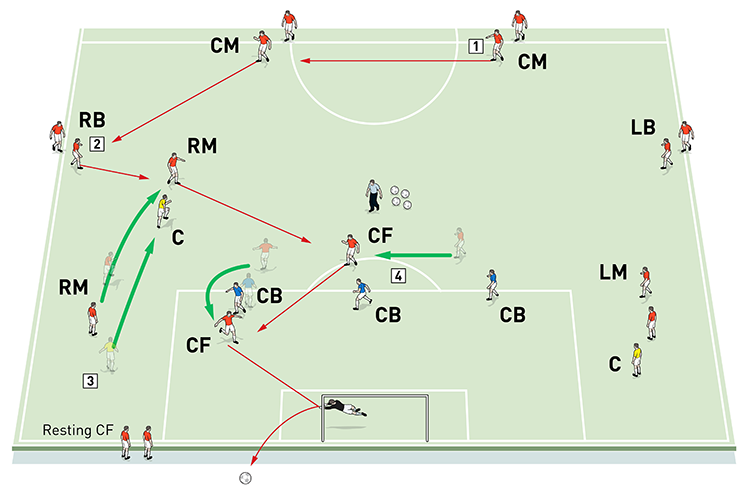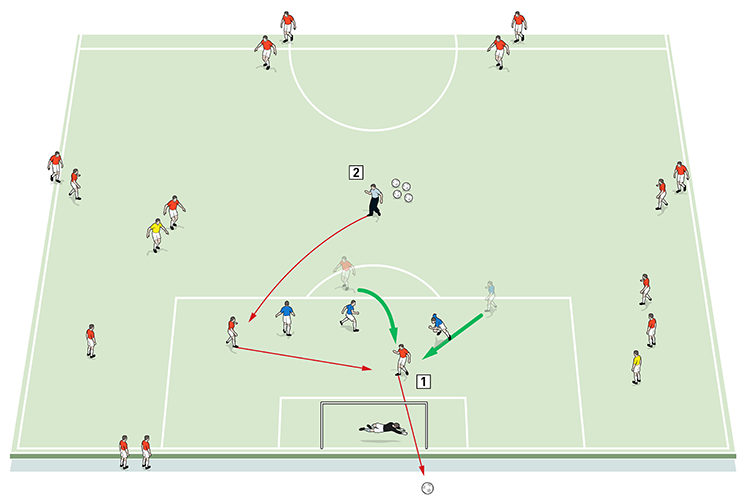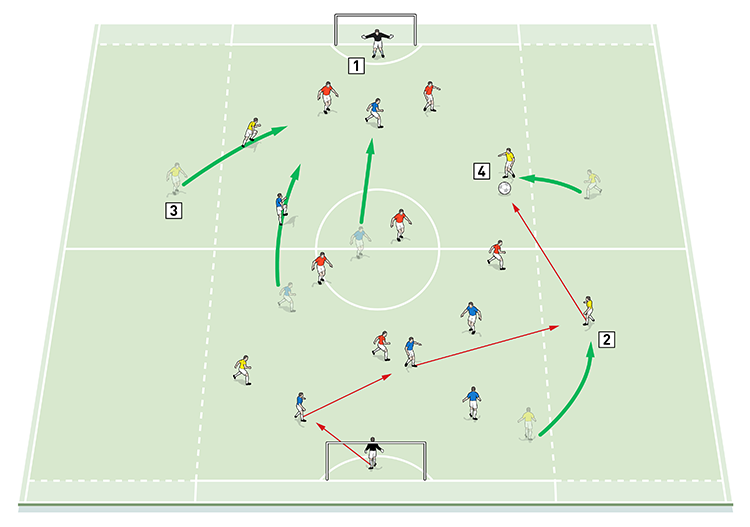You are viewing 1 of your 1 free articles
Developing inside forwards
This session is all about working on opportunities for wide players to receive the ball infield – it helps them to understand how and when to come inside to receive and it also shows them the impact it has on our attacking team shape. This session is taken directly from our Crystal Palace training ground at this phase of the season. It’s a very simple session but I feel it is important that the players are constantly given the opportunity to rehearse how we want to attack as a team.
| Area | Up to two thirds of pitch |
| Equipment | Balls, bibs, cones, 2 goals |
| No. of Players | 22 players + 2 goalkeepers |
| Session Time |
Rotational passing practice: 15mins, Semi opposed pattern: 20mins, Small-sided game: 20mins |
This session is all about working on opportunities for wide players to receive the ball infield – it helps them to understand how and when to come inside to receive and it also shows them the impact it has on our attacking team shape.
This session is taken directly from our Crystal Palace training ground at this phase of the season. It’s a very simple session but I feel it is important that the players are constantly given the opportunity to rehearse how we want to attack as a team.
This is a session that could typically be done on a match day -2. It doesn’t need lots of coaching as the practice coaches itself.
ROTATIONAL PASSING PRACTICE
We set up on half a pitch. We’re using 22 players positioned around the pitch as shown, and we focus on the rotation of the full backs and the wide players.
The players pass and follow their pass, working the ball around the area. After following the ball to the next station, each player should take up a position at the back of the queue where they passed the ball to, as shown [1]. When one player passes and moves, the player behind becomes the new passer the next time the ball comes around.
1

2. The wide midfielders should come inside to receive and work on closed and open turns
3. After following the ball to the next station, each player should take up a position at the back of the queue
4. The player behind the passer becomes the new passer when the next ball comes around
5. We want to see the wide players using good timing when they come inside to receive
We want to see the wide players working on closed and open turns and making well-timed and correctly weighted passes, as well as using safe side passing.
SEMI-OPPOSED PATTERN OF PLAY
We set up on half a pitch. We’re using 22 players including a goalkeeper. The players are split into a red team of 18, with four centre midfielders, two right backs, two left backs, two right midfielders, two left midfielders and four centre forwards. The players are set up in their usual match positions, as shown, with two players waiting in each position and with two of the centre forwards waiting off the pitch ready to rotate in. The blue team is made up of three centre backs and the goalkeeper, who are set up to defend the goal that the reds are attacking. We also use two additional coaches to help put some pressure on the wide midfielders.
The ball starts on the halfway line with the centre midfielders, who pass to each other and then pass out wide to the right back. The right back passes inside to the right midfielder, who moves to receive. To add realism to the move, the midfielders are pressured by a coach as they receive the ball, encouraging them to use good timing and a firm physical presence.
They pass to the centre forwards, who move from outside the D to attack the penalty area against the three blue defenders, as shown [2a].
2a

2. The full back passes inside to the wide midfielder, who moves inside to receive
3. A coach puts pressure on the wide midfielder to add realism to the move
4. The forwards move to attack the three centre backs and try to score in the goal
When the attack is dead, the coach plays a second ball into the strikers and they try to score again, as shown [2b]. When the second attack is dead, the coach plays a third ball into the strikers who try to finish once again.
2b

2. A third attack is launched by the coach before players reset for the next passing sequence, with the waiting players taking their turn to rotate in
After the final attack has played out, the players should reset for the next passing sequence, with the waiting player stepping forward at each position to take their turn. The two centre forwards should also swap with the waiting strikers.
After running the sequence again, vary the play so the ball comes down the opposite wing next.
SMALL-SIDED GAME
We set up between the penalty areas of a normal pitch, with a goal and a goalkeeper at each end and a wide channel marked on either side of the main area. We’re using 16 outfield players, split into two teams of six plus four neutral players who play as wide defenders and wide midfielders for the team in possession.
We play a normal 6v6 game plus keepers but no players from either of the teams of six can enter the wide channels. Indeed, only one of the neutral players is allowed in each wide channel at a time, as shown [3]. This condition creates a situation where the wide defenders and wide midfielders are always on different lines, with one having to move inside to receive the ball.
3

2. Four yellow neutrals play as wide defenders and wide midfielders for the team in possession
3. Only one neutral is allowed in the wide channel at a time, so the wide defenders and wide midfielders are always on different lines
4. Here the wide midfielder moves inside to receive from the wide defender and is in a position to create a scoring opportunity
What are the key things to look for?
One of the key things we are looking for during this session is for players to create space to receive in the pocket. This might come from individual movement from a wide player or a run from the centre forward. We also want to see that players recognise the right time to receive in the pocket.
Another key point is that the wide midfielder should work with the full back on being on different lines. We also want to see different styles of receiving technique from the players.
What are the typical mistakes players might make and how do I avoid them?
Players sometimes try to force the play when space is too tight, or select the wrong turn when receiving under pressure.
Related Files
Editor's Picks
Intensive boxes drill with goals
Penetrating the final third
Creating and finishing
My philosophy
Pressing initiation
Compact team movement
Defensive organisation
Back three tactics
Counter-pressing as an offensive weapon
Coaches' Testimonials

Alan Pardew

Arsène Wenger

Brendan Rodgers

Carlos Carvalhal

José Mourinho

Jürgen Klopp

Pep Guardiola

Roy Hodgson

Sir Alex Ferguson

Steven Gerrard
Coaches' Testimonials

Gerald Kearney, Downtown Las Vegas Soccer Club

Paul Butler, Florida, USA

Rick Shields, Springboro, USA

Tony Green, Pierrefonds Titans, Quebec, Canada
Join the world's leading coaches and managers and discover for yourself one of the best kept secrets in coaching. No other training tool on the planet is written or read by the calibre of names you’ll find in Elite Soccer.
In a recent survey 92% of subscribers said Elite Soccer makes them more confident, 89% said it makes them a more effective coach and 91% said it makes them more inspired.
Get Monthly Inspiration
All the latest techniques and approaches
Since 2010 Elite Soccer has given subscribers exclusive insight into the training ground practices of the world’s best coaches. Published in partnership with the League Managers Association we have unparalleled access to the leading lights in the English leagues, as well as a host of international managers.
Elite Soccer exclusively features sessions written by the coaches themselves. There are no observed sessions and no sessions “in the style of”, just first-hand advice delivered direct to you from the coach.








